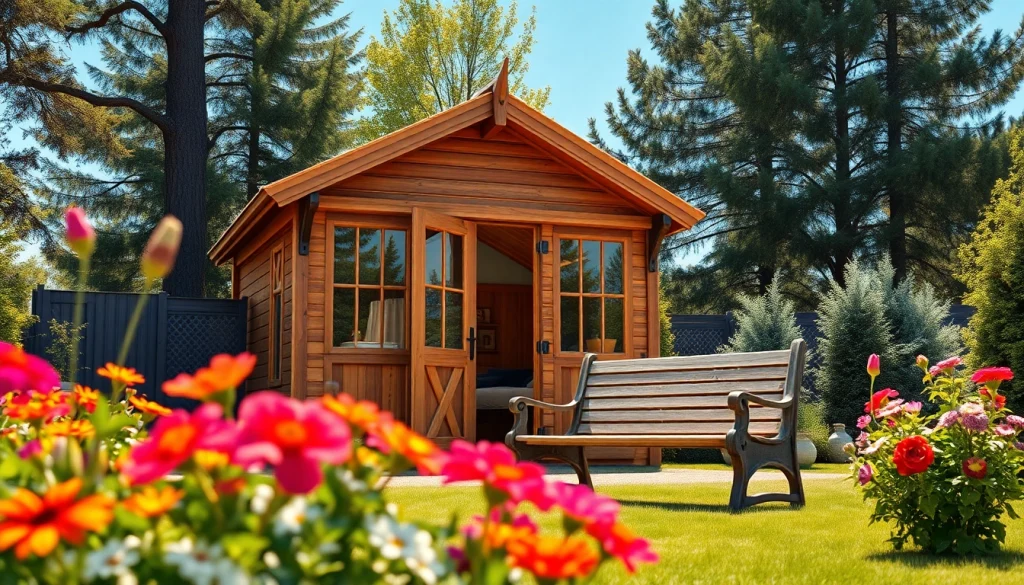Understanding Custom Made Storage Sheds
What Are Custom Made Storage Sheds?
Custom made storage sheds are versatile structures designed specifically to meet the unique needs of individual homeowners or businesses. Unlike standard sheds that come with predefined sizes, designs, and functionalities, custom sheds allow for personalization in dimensions, materials, layouts, and additional features. These bespoke solutions can serve various purposes, such as gardening, additional storage, workspaces, or even recreational areas. One notable appeal of custom made storage sheds is their flexibility to adapt to different landscape configurations, climatic conditions, and user requirements, resulting in functional, aesthetically pleasing outdoor spaces.
Benefits of Choosing Custom Made Options
Choosing a custom made storage shed offers numerous benefits tailored to personal preferences and needs:
- Personalization: Customers can select every aspect of the shed, from size and shape to color and materials, ensuring that it fits seamlessly into their existing landscape and matches the aesthetics of their home.
- Optimal Use of Space: Custom sheds are built to fit specific spaces, allowing homeowners to utilize areas that might otherwise go unused, such as awkward corners or sloped gardens.
- Quality Craftsmanship: Custom sheds often utilize higher-quality materials and construction methods, resulting in superior durability compared to mass-produced options.
- Enhanced Functionality: Custom features like built-in shelving, windows, and electrical outlets can be included based on the intended use, whether for storage, as a workshop, or as a garden office.
- Increased Property Value: Well-designed and high-quality structures can add significant value to a property, appealing to potential buyers in the future.
Common Materials Used in Construction
The choice of materials for custom storage sheds significantly impacts their durability, maintenance, and cost. Common materials include:
- Wood: A traditional favorite, wooden sheds provide an attractive, natural look. Cedar and pine are popular choices due to their resistance to rot and insects.
- Vinyl: Vinyl sheds are low-maintenance and resistant to warping, cracking, and fading, making them an appealing option for many homeowners.
- Metal: Steel and aluminum are robust materials that can withstand harsh weather conditions. Metal sheds usually require less maintenance but can be prone to rust if not properly treated.
- Composite Materials: These are engineered products made from a combination of wood fibers and plastic, offering the appearance of wood while resisting rot, insects, and weather damage.
Designing Your Custom Shed
Factors to Consider in Shed Design
Designing a custom shed involves careful consideration of several key factors:
- Purpose: Understanding how you plan to use the shed will dictate its design. A garden tool storage shed will differ greatly in layout and features from a workshop or hobby space.
- Space Availability: Measure your available land and assess access routes for delivery and construction. Proper planning ensures that the shed fits comfortably within your yard.
- Style and Aesthetics: Choose a style that complements your home and garden. Popular design styles include traditional, modern, or rustic. Color selection also plays a key role in visual harmony.
- Future Needs: Consider not only current but also future storage or workspace requirements. Designing with potential expansion in mind can save costs later on.
Popular Styles and Customization Options
The design of your storage shed can include various popular styles and features:
- A-Frame Sheds: Ideal for maximum headroom and rain runoff, they are one of the most recognizable designs.
- Gable Sheds: Known for their sloped roof that provides better ventilation and prevents snow accumulation.
- Lean-To Sheds: These are attached to a building or structure, making them a space-saving option while providing easy access.
- Customization Options: Enhanced features such as windows, skylights, lofts, and built-in storage solutions can be seamlessly integrated into the design.
Examples of Custom Shed Designs
Real-world examples can inspire your design decisions:
- A dual-purpose garden shed that includes shelving for tools and a potting bench.
- A workshop shed equipped with electrical outlets, overhead lights, and a foldable workbench for efficiency.
- A creatively designed kids’ playhouse/shed that combines storage for toys and a whimsical exterior.
Building Your Shed: A Step-by-Step Guide
Planning Your Custom Shed
Building your custom storage shed begins with diligent planning:
- Define Objectives: Clearly outline what you need – storage space, a workshop, etc.
- Set a Budget: Determine a realistic budget that includes materials, labor, and permits.
- Research Building Codes: Investigate local zoning laws and building regulations to ensure compliance.
Permits and Regulations to Keep in Mind
Before construction, understanding local regulations is crucial:
- Zoning Laws: Check if your property falls under specific zoning codes, which may dictate the size and location of your shed.
- Building Permits: Depending on your local government, you may need to obtain a permit for constructing an outbuilding.
- Homeowners Association (HOA) Rules: If applicable, make sure to comply with your HOA’s rules regarding additional structures.
Selecting the Right Builder
If you are not building the shed yourself, selecting the right contractor is crucial:
- Experience: Choose a builder with experience in constructing custom storage sheds.
- Portfolio: Review their previous work to assess craftsmanship and design style.
- References and Reviews: Check online reviews and ask for references from previous clients to gauge reliability.
Maintaining Your Custom Made Storage Shed
Routine Maintenance Tips
To ensure longevity and functionality, regular maintenance is essential:
- Inspect for Damage: Regularly check for signs of wear, such as loose hinges, or cracks.
- Clean Gutters and Drains: Keeping gutters and drains clean prevents water accumulation which can lead to rot.
- Repaint and Reseal: Over time, protect wood surfaces from moisture and pests by repainting or resealing as needed.
Upgrades to Enhance Functionality
Consider these upgrades for additional versatility:
- Insulation: Adding insulation allows for year-round usage, especially in extreme weather conditions.
- Electrical Outlets: Include electrical outlets for tools and lighting, transforming the shed into a usable workspace.
- Custom Shelving: Built-in shelving can maximize storage efficiency and organization.
Seasonal Care Considerations
Depending on your climate, seasonal changes may dictate specific maintenance:
- Winter Preparations: Clear snow accumulation and ensure proper insulation to prevent damage from freezing conditions.
- Summer Maintenance: Regularly check for insect activity and maintain proper ventilation to avoid excess humidity.
Finding the Right Custom Shed Builder
Researching Local Builders
Finding the right builder is essential for a high-quality result:
- Online Research: Use search engines and social platforms to find local builders specializing in custom sheds.
- Home Shows and Expos: Attend local home improvement shows to meet builders and see their displayed work.
- Community Recommendations: Seek recommendations from neighbors or local community groups.
Questions to Ask Potential Builders
Engage potential builders in comprehensive discussions:
- What’s your experience with custom builds?
- Do you provide warranties for your work?
- Can you provide references from past clients?
Reading Reviews and Testimonials
Reviews and testimonials give insights into a builder’s quality and reliability:
- Check Home Improvement Websites: Websites like Angie’s List, Yelp, or local business directories provide user reviews.
- Social Media Feedback: Check builder sites on social media for customer interactions, showcasing their responsiveness and quality.





